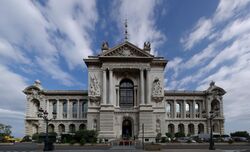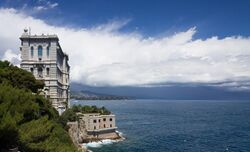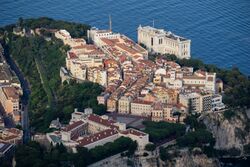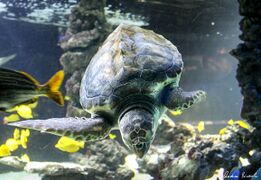Earth:Oceanographic Museum
The Oceanographic Museum (Musée océanographique) is a museum of marine sciences in Monaco-Ville, Monaco. It is home to the Mediterranean Science Commission. This building is part of the Oceanographic Institute which is committed to sharing its knowledge of the oceans.[1]
History
The Oceanographic Museum was inaugurated in 1910 by Monaco's modernist reformer, Prince Albert I.[2] Jacques-Yves Cousteau was director from 1957 to 1988. The Museum celebrated its centenary in March 2010, after extensive renovations.
Overview
This monumental example of highly charged Baroque Revival architecture has an impressive façade above the sea, towering over the sheer cliff face to a height of 279 feet (85.04 m). It took 11 years to build, using 100,000 tons of stone from La Turbie.[3]
The museum is home to exhibitions and collections of various species of sea fauna (starfish, seahorses, turtles, jellyfish, crabs, lobsters, rays, sharks, sea urchins, sea cucumbers, eels, cuttlefish etc.). The museum's holdings also include a great variety of sea related objects, including model ships, sea animal skeletons, tools, weapons etc., as well as a collection of material culture and ritual objects made from, or integrating materials such as pearls, molluscs and nacre.[3][4]
At the first floor, A Sailor’s Career showcases the work of Prince Albert I. It includes the laboratory from L’Hirondelle, the first of Prince Albert's research yachts. Observations made there led to an understanding of the phenomenon of anaphylaxis, for which Dr Charles Richet received the Nobel Prize in Physiology or Medicine in 1913.[3]
An aquarium in the basement of the museum presents a wide array of flora and fauna. Four thousand species of fish and over 200 families of invertebrates can be seen. The aquarium also features a presentation of Mediterranean and tropical marine ecosystems.[3]
Numerous artists displayed their artworks in the museum, such as Damien Hirst and Philippe Pasqua.[5]
Caulerpa taxifolia
In 1989, French marine biologist Alexandre Meinesz discovered a patch of a giant, tropical seaweed Caulerpa taxifolia directly under the walls of the museum. Several documentaries point to this patch as the origin of one of the largest seaweed contaminations of the Mediterranean Sea in recent history. The role of the museum and its director, François Doumenge when the discovery was made public is still heavily debated.[6]
Gallery
References
- ↑ "The Oceanographic Institute, Foundation Albert I, Prince of Monaco". Monaco Blue Initiative. http://www.monacoblueinitiative.org/en/organizers/oceanographic-institute-foundation-albert-i-prince-of-monaco/. Retrieved 2 November 2014.
- ↑ Waldman, Carl; Mason, Catherine (2006). Encyclopedia of European Peoples. Infobase Publishing. p. 529. ISBN 978-1-4381-2918-1. https://books.google.com/books?id=kfv6HKXErqAC&pg=PA529.
- ↑ 3.0 3.1 3.2 3.3 "The Oceanographic Museum of Monaco". Association for the Sciences of Limnology and Oceanography. Archived from the original on 24 April 2012. https://web.archive.org/web/20120424110940/http://www.aslo.org/nice2009/museum.html. Retrieved 6 May 2013.
- ↑ Mourad, Bariaa, P.-Fromm, Gérald A. and Carpine, Christian (eds.), ed (1992). "Art de la nacre, coquillages sacrés". Rapport de recherche sur la provenance et l'authenticité d'une collection du Musée Océanographique. Monaco: Musée Océanographique.
- ↑ De Santis, Sophie (15 May 2017). "Philippe Pasqua, «Borderline»" (in fr). Le Figaro. http://www.lefigaro.fr/arts-expositions/2017/05/15/03015-20170515ARTFIG00085-philippe-pasqua-borderline.php. Retrieved 2017-05-25.
- ↑ Davidson, Nick (2003-04-01). "Transcript of "Deep Sea Invasion"". PBS and BBC. https://www.pbs.org/wgbh/nova/transcripts/3008_algae.html. Retrieved 2010-05-10.
External links
- Official website (in French) (in English)
- Monaco Official Site: Information on the Museum
- Oceanographic Museum for visitors to Monaco
[ ⚑ ] 43°43′51″N 7°25′31″E / 43.73083°N 7.42528°E








